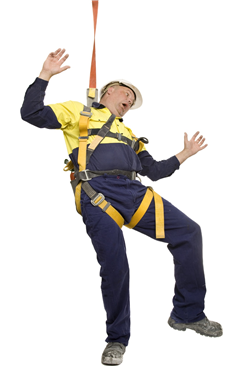
When working at height, a safety lanyard connects a harness to a secure anchor point, preventing the wearer from falling to the ground.
There are two types of safety lanyard, and it's important to know the difference between them.
Restraint Lanyard vs. Fall Arrest Lanyard
A restraint lanyard is designed to prevent falls by prohibiting the wearer from reaching a hazardous position where a fall might occur. For example, one may wear a safety harness and a restraint lanyard while working on an aerial work platform - the length of the lanyard will have been specifically chosen to keep the wearer safely on the platform.
A fall arrest lanyard must be used in situations where fall hazards cannot be avoided. Fall arrest lanyards have an energy-absorbing element that, in the event of a fall, reduces the impact force exerted on the wearer's body and the anchoring point.
More Information: Fall Arrest vs. Fall Restraint
What Are Safety Lanyards Made Of?
Restraint lanyards (which, remember, are intended to stop people reaching a position where a fall could occur) are typically made of kernmantle rope. Our kernmantle rope lanyards have a minimum breaking strength of 22kN.
We can also supply lanyards with elasticated webbing to help reduce possible trip/snagging hazards.
Both types of lanyard can be purchased from SafetyLiftinGear's Lanyards department.
Connectors
A safety lanyard may be supplied with a variety of different connectors, including:
- Screw gate karabiner
- Automatic locking gate
- Scaffold hook
- Thimble eye
Maximum Lifespan
The G-Force lanyards we sell here at SafetyLiftinGear have a maximum lifespan of 10 years from the date of manufacture (assuming that you use and store the product correctly and subject it to regular, thorough examinations). This maximum lifespan should not be exceeded, and the equipment must be removed from service once the 10-year period has elapsed.
Buy & Hire Safety Lanyards >

